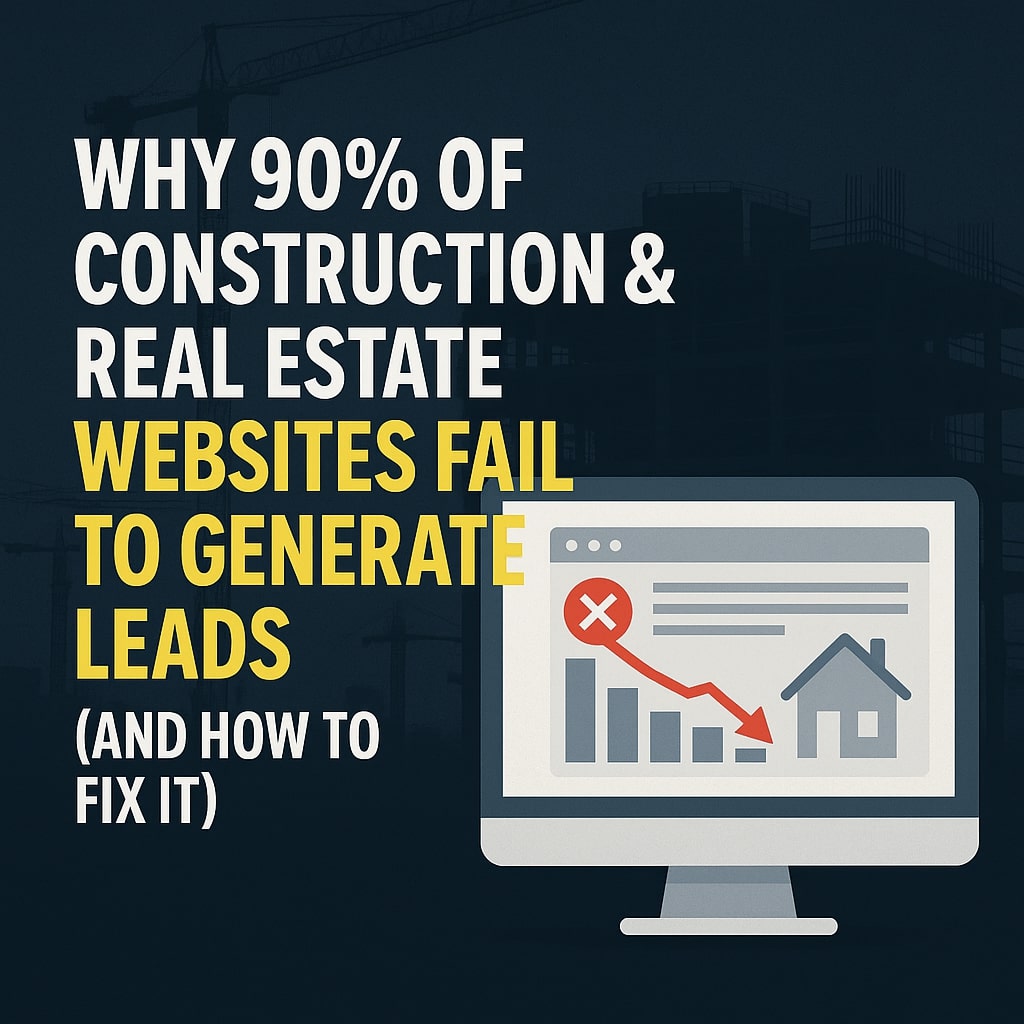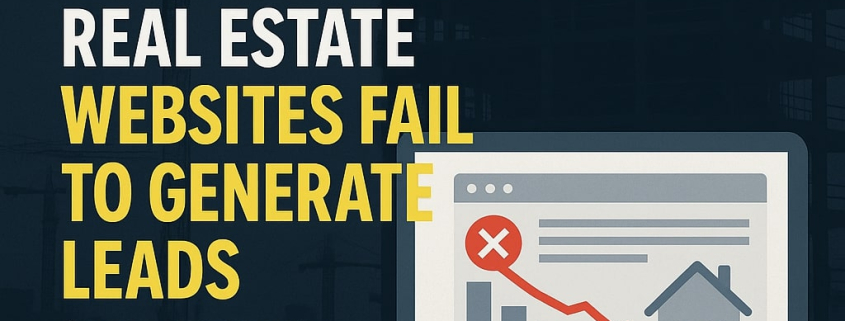Why 90% of Construction & Real Estate Websites Fail to Generate Leads (and How to Fix It)

Most developer, builder, or real estate firm websites look nice. But many fail at their real job: generating qualified leads. In fact, I estimate 9 out of 10 fail at this.
Why does this happen? Because owners trap themselves in a “build-it-and-they-will-come” mindset. They think a good-looking website is enough. It isn’t.
To turn your site into a lead engine, you must understand the gaps and fix them. Below are the most common failures, along with their corrections.
1. They Ignore Local SEO and Visibility
A beautiful site does nothing if no one sees it. In real estate and construction, your clients are local (or regional). If your website isn’t ranking where your prospects search, it’s invisible.
- Many websites don’t optimize for local search terms like “residential developer in Austin” or “commercial contractor Dallas.”
- Google Business Profile (formerly Google My Business) is left unfinished or unclaimed.
- NAP (Name, Address, Phone) details are inconsistent across listings, directories, and your site.
- Few websites build local citations or backlinks from local sources.
Without visibility, your site can’t generate leads. Resolve this issue by focusing on local SEO, including a consistent NAP, an optimized Google Business Profile, relevant local keywords, and accurate citations.
2. No Clear Conversion Strategy (Weak or Missing Funnel)
Many sites treat themselves as brochures, not funnels. They show “About Us,” “Projects,” and “Services,” but nothing points people to take action.
A lead-generating website uses a funnel mindset:
- Strong hooks/headlines that answer visitor needs
- Clear calls-to-action (request quote, schedule consult, download guide)
- Minimal distractions on landing pages
- Follow-up mechanisms (email, chatbots, retargeting)
Without a conversion strategy, traffic may come—but leads won’t. You need to turn casual visitors into engaged prospects.
3. Headlines and Messaging Don’t Speak to Real Needs
Visitors want solutions, not sales fluff. Yet many real estate or construction sites lead with generic claims: “We build quality homes” or “Top developer since 2000.”
That doesn’t connect emotionally.
Better headlines focus on immediate client pain or desire:
- “Get a Free Estimate in 24 Hours for Your Roof Repair”
- “Pre-sale Your Development with Zero Upfront Risk”
If the headline fails to capture attention within the first few seconds, visitors will bounce.
4. Confusing, Busy Design Kills Focus
Overloaded pages with too many elements can be distracting to people. A cluttered layout makes choices confusing.
The right landing experience is simple:
- White space to give breathing room
- Obvious buttons for action
- Mobile-first design (most visitors use phones)
- Fast loading (optimize images, use caching)
Busy pages kill conversions. Each extra link, image, or block must be intentional—and ideally, lead toward the next step.
5. Lack of Trust Signals & Social Proof
Prospects in the construction and real estate sectors are investing substantial sums. They look for evidence that you can deliver.
Yet many sites neglect trust elements:
- No client testimonials (with names, photos, projects)
- No project case studies or before/after visuals
- No logos of associations, certifications, or media features
- No “as seen in” or press mentions
These elements reduce perceived risk. Strong branding and social proof reassure a prospect that you’re a trustworthy partner to do business with.
6. Poor Technical Setup & Performance
Even a well-designed site can fail if it experiences technical issues. You lose visitors fast if it’s slow, broken, or hard to use.
Common technical issues:
- Slow page speed (huge images or unoptimized code)
- Broken links, missing pages, or 404 errors
- No mobile responsiveness
- Missing SSL (site insecure)
- Poor site structure, navigation, and internal linking
These problems hurt both user experience and SEO. Fixing them is low-hanging fruit—but many firms never take advantage of it.
7. Keyword Strategy Too Broad or Generic
Many construction and real estate sites aim to rank for broad keywords like “developer,” “contractor,” or “real estate agency.” The problem? Competition is fierce.
Instead, you need geo-targeted, niche, and intention-driven phrases:
- “Mixed-use developer in Austin, TX”
- “Boutique condo developer near Miami Beach”
- “Commercial contractor for retail build-outs”
Each service or project type you offer should have its own SEO-optimized page with local context. That helps Google show you for relevant queries.
8. Poor Content Strategy & Weak Blogging
If you rely solely on static pages, you miss opportunities. Google values content that answers real questions and uses targeted keywords.
Content gaps:
- No blog or articles addressing prospect questions
- Content is generic, not tailored to your niche or market
- No regular updates (freshness matters in SEO)
- No internal linking or content structure
A strong content plan amplifies your authority, helps with SEO, and gives you more chances to attract leads.
How to Fix These Failures: The Lead-Generating Website Checklist
Here’s how to turn your site into a lead engine:
A. Audit Your Local SEO & Visibility
- Claim and fully optimize your Google Business Profile
- Ensure NAP is consistent across all platforms
- Build local citations (business directories, local blogs, chamber sites)
- Target geo-specific keywords
B. Build a Funnel, Not Just Pages
- Create landing pages with a single focus (quote, consultation, download)
- Use headlines that address visitor desires or pain points
- Minimal distractions; make paths to action obvious
- Add follow-up elements (email sequences, chat, retargeting)
C. Strengthen Your Messaging
- Craft clear, solution-oriented headlines
- Use subheadlines to support the main message
- Speak benefits and outcomes, not features
- Avoid jargon—speak in language your clients use
D. Simplify Design & Improve UX
- Use clean layouts and plenty of white space
- Place CTAs prominently (top, middle, bottom)
- Make the mobile version seamless and fast
- Optimize images and technical performance
E. Add Trust Signals
- Showcase testimonials with photos and stories
- Add case studies and project highlights
- Display logos of certifications, awards, and associations
- Feature press coverage or media mentions
F. Fix Technical Issues
- Improve page speed (compress images, minimize scripts)
- Ensure all pages are mobile-friendly
- Fix broken links and missing pages
- Use SSL and make site secure
- Organize site structure logically; use breadcrumbs
G. Refine Keyword Strategy
- Do keyword research for your niche and service areas
- Build pages per service, region, or project type
- Use keywords naturally in titles, headings, and content
- Use schema markup and local SEO features
H. Develop a Content Engine
- Write blog posts that answer standard buyer questions
- Publish regularly to show freshness
- Use internal links to connect content and service pages
- Promote your content (social, email, backlinks)
Real-World Example (to Make It Real)
A boutique developer in New England rebranded their project as “Tide & Timber Commons,” tying identity to local heritage. They used storytelling across design, signage, and website. Leasing velocity went up ~25% compared to nearby projects. The brand halo even carried over to future developments.
This demonstrates what a lead-generating site and branding can achieve when combined.
Final Thoughts & Call to Action
A website that only looks pretty but fails to convert is a missed opportunity. In construction and real estate, leads are gold.
Focus on visibility, messaging, funnel design, trust, and technical excellence.
Your next move:
Pick one of the failure categories above. Audit your site. Fix that issue this week. Once you gain traction in one area, repeat with the next.
When your site starts pulling in qualified leads reliably, you’ll reduce your dependence on referrals and ads—and win more business.
If you need help auditing your site or writing conversion-focused content, please let me know. I’d be glad to help you turn your website into your strongest salesperson.





Leave a Reply
Want to join the discussion?Feel free to contribute!